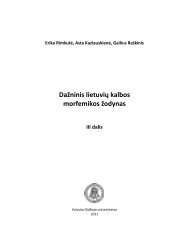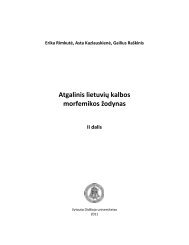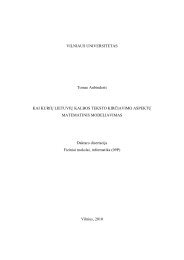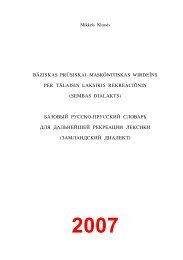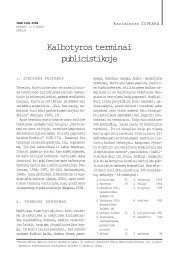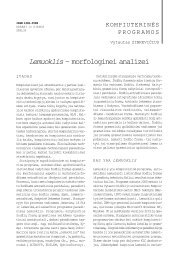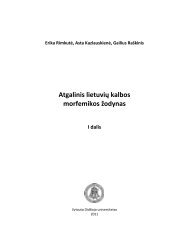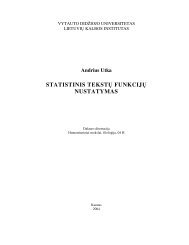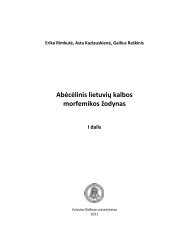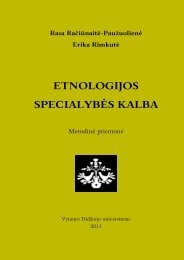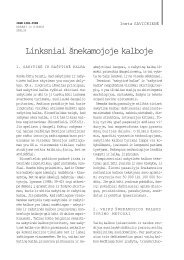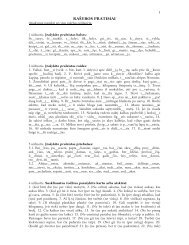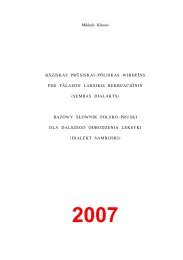HISTORICAL GRAMMAR OF OLD PRUSSIAN
HISTORICAL GRAMMAR OF OLD PRUSSIAN
HISTORICAL GRAMMAR OF OLD PRUSSIAN
Create successful ePaper yourself
Turn your PDF publications into a flip-book with our unique Google optimized e-Paper software.
<strong>HISTORICAL</strong> <strong>GRAMMAR</strong> <strong>OF</strong> <strong>OLD</strong> <strong>PRUSSIAN</strong><br />
Pr. (Cat.) gen. pl. *-an was supported by its phonetic coincidence<br />
with Pr. (Cat.) acc. sg. *-an, both forming so-called “general case” [casus<br />
generalis (acc. sg. = gen. pl.)]. It was the latter a-stem pattern, according<br />
to which an innovative i-stem gen. pl. (Cat.) *-in (cf. nidruwîngin III<br />
121 ) came into being.<br />
5<br />
* 100. Acc. pl. (masc.) Pr. *-ans (with undoubtful -‹an) is<br />
attested in the Catechisms, cf.: Deiwans (I, II, III) ‘deities’, t`wans (III)<br />
‘fathers’, etc., adj. maldans ‘young’, etc. This -ans cannot be easily put<br />
into connection with EBalt. acc. pl. -us (Lith. têvus = Latv. t…ev-us), plg.<br />
Bûga III 703 (although the problem of Pr. -ans is not discussed),<br />
Endzelîns BVSF 117, Stang Vergl. Gr. 186, Kazlauskas LKIG 176.<br />
I should like to reconstruct Balt. acc. pl. masc. *-#ôns which, in course<br />
of development, manifested in 2 allomorphs (cf. ** 18, 19):<br />
1) as an accented Balt. *-×#ôns > EBalt. *-×#ôs40 > Lith.-Latv. -us (cf.<br />
Endzelîns l. c., Stang l. c., Kazlauskas l.c.), and<br />
2) as an unaccented Balt. *-#`ns > WBalt. *-#`ns > Pr. -ans (cf. Stang<br />
l. c.). This WBalt. *-#`ns coincided with WBalt. acc. pl. fem. *-#`ns41 which<br />
had replaced an older WBalt. *-#`s < Balt. *-#`s (> Lith.-Latv. -as), cf. BS<br />
185 ff., 311 f.<br />
* 101. Rosinas BÁM 82 ff. (with bibliograhy) has formulated a<br />
hypothesis that Pr. acc. pl. masc. -ans goes back to Balt. *-ôs which, when<br />
unstressed, turned into WBalt. *-`s, but the latter, due to “secondary nasalization”,<br />
turned into Pr. *-…às, spelled as -ans in the Catechisms.<br />
40 V. Maþiulis explains East-Baltic denasalization in *-×#ôns due to mostly redundant character of<br />
its -n- in plural in the opposition acc. sg. *-an : acc. pl. *-×#ôns, cf. BS 188. For an alternative view<br />
that Eastern Baltic never possessed acc. pl. *-×#ôns but developed its acc. pl. *-×#ôs independently,<br />
cf. Palmaitis BGR 100 f. – L.P.<br />
41 The assumption of this secondary acc. pl. fem. *-#`ns in Western Baltic had to explain the<br />
survival (due to systemic reasons) of acc. pl. masc. *-#`ns in spite of its redundant -n- (BS ibid.).<br />
For an alternative view of -n- formally transferred into Prussian masculine and feminine plural in<br />
accordance with the pattern *-an in singular, cf. Palmaitis ibid. – L.P.<br />
47



